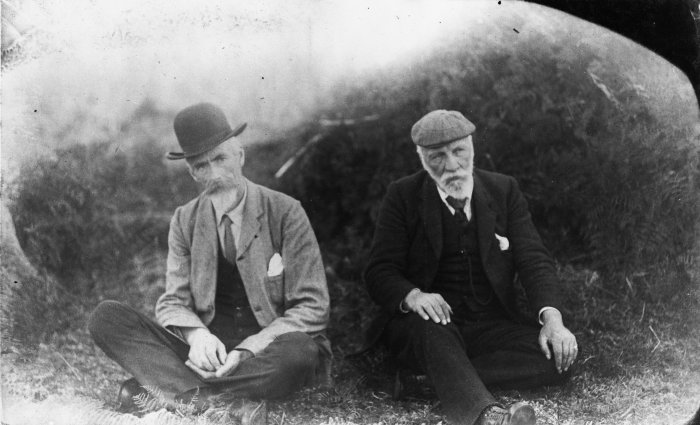- Elsdon Best
.
Early life and career
Elsdon Best was born
30 June 1856 atTawa Flat ,New Zealand , moving with his family toWellington at the age of 9, where he went to school. He passed the Civil Service Examination and became a clerk in 1873, but within a year found the work uncongenial and moved to the east coast, where he worked in farming and forestry. In 1881, he joined the Armed Constabulary, but soon left it to travel, visiting Hawaii and then California, where he worked in cattle mustering and lumbering.In 1886, Best returned to New Zealand, resuming his life in the bush where he came into increasing contact with the Māori, whose language he learned and culture he began to study. When the
Polynesian Society was founded in 1892, Best was working in Wellington in a warehouse, and wrote an article on the people of the Philippines and submitted it to the society's new journal. He also began a series on the history of Wellington Harbour.Work among the Tūhoe
In 1895, when the Urewera district began to be opened up for European settlement, Best took a position as timekeeper with the road works, beginning in
Te Whaiti . For the next 15 years, he worked in the district, using his presence in the area to record the facts of the culture and traditions of the Tūhoe, which were still relatively intact. He recorded his observations in field records and note books that he kept now for the rest of his life.Best's devotion to his study, together with his facility in Māori, allowed him to win the confidence of the Tūhoe, whose traditions he published in a series of articles in the "
Transactions of the New Zealand Institute " and the "Journal of the Polynesian Society". In 1897, he published the monograph "Waikaremoana, the Sea of Rippling Waters, With a Tramp through Tuhoe Land", in which he presented the lore of the district.Ethnologist
thumb|rught|240px|Elsdon Best with fellow ethnographer S. Percy Smith, 1908 [">Photograph by kind permission of the Alexander Turnbull Library, Wellington, New Zealand, reference number: 1/2-028237-F] In 1910, Best was appointed ethnologist at the Dominion Museum which allowed him to pursue his researches in a more focused manner. In 1912, he published "The Stone Implements of the Maori", which was followed four years later by an accompanying bulletin on Māori storehouses. In 1919, his "The Land of Tara" appeared, a history of the Māori of Wellington Harbour. A systematic survey of traditional Māori culture, "The Maori", appeared in two volumes in 1924, and in 1925 Best's "Tuhoe, the Children of the Mist" and their leader and self proclaimed prophet from Maungapohatu,Rua Kenana Hepetipa . This a monumental study in 1200 pages of the traditional history and culture of tribe with which he had spent so much of his life.In 1914, Best was awarded the
Hector Medal of the New Zealand Institute, and in 1919 he was made a fellow.Best died in 1931 in Wellington, survived by his widow Adelaide (née Wylie). They had no children.
Notes
References
*"Encyclopedia of New Zealand", vol. 1, pp. 199-200.
*"Journal of the Polynesian Society" 41 (1932)External links
* [http://www.dnzb.org.nz/DNZB/alt_EssayBody.asp?essayID=2B20 Dictionary of NZ Biography entry]
* [http://rsnz.natlib.govt.nz/volume/rsnz_62/rsnz_62_00_001940.html Obituary by Te Rangi Hiroa in "Transactions of the Royal Society of New Zealand" (of which he was a founder member)]
* [http://www.teara.govt.nz/1966/B/BestElsdon/BestElsdon/en Biography in 1966 "Encyclopaedia of New Zealand]
* [http://library.wcc.govt.nz/maori/wellington/landoftara.html "The Land of Tara" in Wellington Public Library website]
* [http://www.tawahistory.wellington.net.nz/press.html "Best of Tawa" new book]
* [http://rsnz.natlib.govt.nz/volume/rsnz_53/rsnz_53_00_000200.html 1921 paper on Old Redoubts, Stockades and Fortifications in Wellington]
Wikimedia Foundation. 2010.

